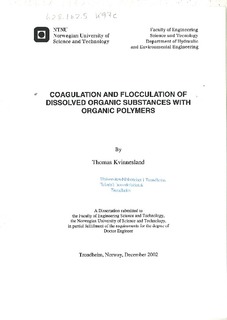| dc.description.abstract | Coagulation of natural organic matter (NOM) in water is a well-established process, enabling or enhancing the removal of these substances by different particle separation processes. The dominating coagulating agents used are, however, inorganic salts of iron (Fe3+) and aluminium (Al3+). The primary use of organic polymers is as flocculating agents for already coagulated aggregates. However, in recent years the use of cationic organic polymers have received increasing attention as coagulating agents, used alone or in combination with the traditional metal salt coagulants.
The objective of this study was to determine how organic cationic polymers can coagulate dissolved organic substances in water. The main focus has been on how differences in chemical composition and charge density of the polyelectrolytes affect their efficiency as coagulants. This was achieved by comparing the efficiencies of low molecular weight poly- Epi-amine, polydiallyldimethylammonium chloride, cationic polyacrylamide and chitosan in jar test experiments on constructed humic water as well as on wastewater biofilm reactor effluent. In order to compare the coagulation of dissolved organic substances as such with the following flocculation of aggregates, sequential filtration through filters of decreasing pore diameters (11 µm through 0,1 µm) was chosen as the particle separation method.
All polyelectrolytes tested were efficient in coagulating NOM in humic water and reached approximately the same maximum levels of coagulation, however, different dosages were required for the different polyelectrolytes.
Results from experiments on humic water at pH 6 indicated that the difference in efficiencies of the different polyelectrolytes as coagulants for NOM are predominantly related to differences in charge density, not to differences in the chemical composition of the polymer chain. Furthermore it was shown that the effect of polyelectolyte charge density is predominantly related to the additions of different amounts of charge equivalents when dosing equal amounts of polyelectrolytes with different charge densities, not to the spatial distribution of charge as such. Experiments performed at pH 4 indicated that the effect of charge addition that was dominating at pH6 is less pronounced at pH4.
Using sequential filtration as the particle separation method showed that the coagulation of dissolved organic substances in particle free humic water by polyelectrolytes and the subsequent flocculation of aggregates are two distinguishable processes with distinguishable dosage optima. With respect to the relationship between coagulation of dissolved organic matter and flocculation in the experiments on biofilm reactor effluent, significant differences in performance were observed with chitosan relative to the synthetic polyelectrolytes. In general, the results indicated that chitosan forms aggregates with dissolved COD that more readily flocculate, internally or with other particulate matter, than the synthetic polyelectrolytes tested.
Direct comparisons of results obtained on particle free humic water and particle rich biofilm reactor effluent indicated strong similarities in the dosage response with respect to coagulation of dissolved organic substances. The presence of particles and absorption of polyelectrolyte to these did not appear to negatively affect the coagulation of dissolved organic matter with polyelectrolyte. Rather these appeared to be a positive effect of the presence of particulate matter on the polymer dose efficiency in coagulation of dissolved organic matter. | nb_NO |
